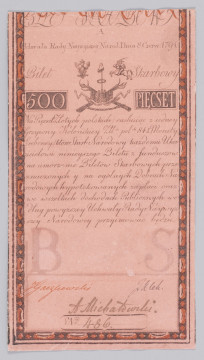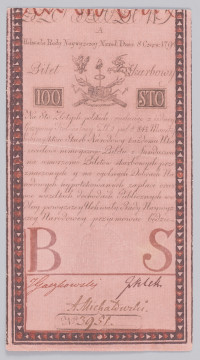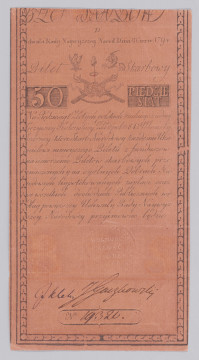
Treasury ticket - 500 Polish zlotys
1794
National Museum in Lublin
Part of the collection: Paper money of the Kościuszko Uprising and the Duchy of Warsaw
The necessity of financing military operations made the authorities of the Kościuszko Uprising decide to print paper money. As a result, on 16 August 1794 treasury tickets with the following denominations were put into circulation: 5, 10, 25, 50, 100, 500 and 1000 zlotys. The decision to introduce four-zloty tickets into circulation was motivated not only by the ongoing war, but other reasons as well. The basic one was the shortage of means of payment of small denominations, necessary in everyday transactions. This was to be remedied by introducing lower denominations into circulation. On 17 September 1794, four-zloty tickets appeared, and on 10 and 20 October - five- and ten-zloty tickets. During the Uprising, one-zloty tickets were issued. The latter entered circulation less than a week before the fall of the uprising. The fact that the four-zloty tickets were not included in the initial plans of issuing them was reflected in their graphic design and the printing material. Tickets of higher denominations were printed on dyed paper of Dutch or Flemish production. In this case, native paper from the Jeziorna Paper Factory was used for printing, the same as was used for producing one-zloty, five- and ten-zloty tickets. The graphic design was not elaborate, and the protection against forgery was limited to the inscription with a special paint: ‘Złł 4’.
During the Kościuszko Uprising, a total of 2,378,604 treasury tickets of various denominations were issued. Their value amounted to 10,885,937 zlotys at that time. The most-issued tickets, both in terms of the number of copies and their value, were those with the face value of 4 zloty, even though they were introduced into circulation less than two months before the fall of the Uprising. Their total circulation was 990,730 copies with a value of 3,962,920 zlotys at that time. The late decision about their introduction into circulation and the subsequent rush resulted in numerous printing errors; moreover, many tickets did not manage to fulfil their role in fact, that is to become a means of payment, or they performed this function for a very short time. This is evidenced, among other things, by surviving sheets on which there are uncut tickets. As a result, four-zloty tickets are currently the most common in numismatic collections.
Leszek Poniewozik
Author / creator
Dimensions
cały obiekt: height: 87 mm, width: 50 mm
Object type
paper money
Technique
woodcut
Creation time / dating
Creation / finding place
Owner
The National Museum in Lublin
Identification number
Location / status

1794
National Museum in Lublin

1794
National Museum in Lublin

1794
National Museum in Lublin
DISCOVER this TOPIC
National Museum in Szczecin
DISCOVER this PATH
Educational path